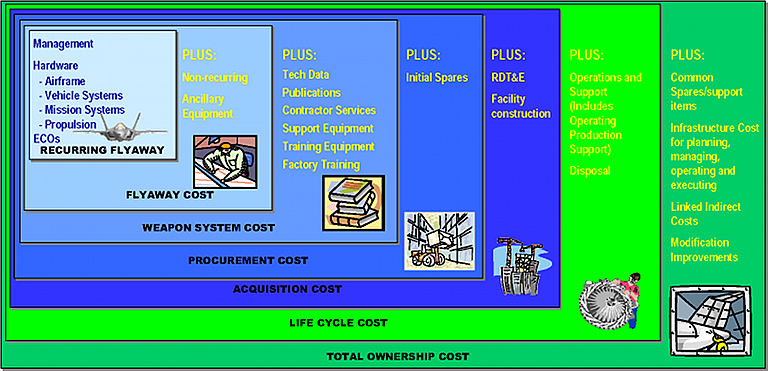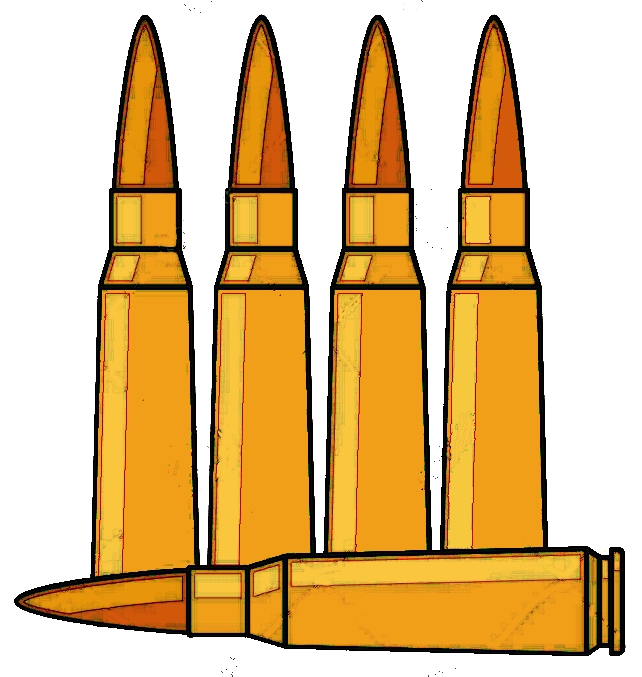Another week, another improvement: We know everyone likes swag and wants to have a say, so we’re introducing a referral rewards program to give you both. Scroll to the bottom to see how it works and what you can win!
|
The Complex World of Computing Cost
|
Counting money should be one of the most straightforward things in life, especially when it’s the cost of a taxpayer-funded weapons system. Unfortunately, it’s not.
What
The answer to “how much does it cost” the fighter pilot standard: it depends. Only in the government does one simple question have
seven
—yes,
seven
—different answers.
On one end of the spectrum are good-news story figures called “recurring flyaway cost.” This is the cheapest way to represent cost and a bit misleading.
On the other end is “total ownership cost.” As the name implies, it’s the total cost of the program over its entire life—from development through sustainment. This is typically used in bad-news stories or for shock value (“$18 billion interceptor!”, “$1 trillion fighter!”, etc.)
In between, there are five other ways to slice the cost. Here is a handy figure to explain it, which also memesplains the title picture above.
|

|
So What
While it may seem unnecessary, these exist to see where the fiscal pain points are in a program. For example, if you plan to keep a weapons program for 50 years, the life cycle cost section will go through the roof (and total ownership cost with it).
When you view cost from this perspective, ideas like the
digital century series fighter
start to make more and more sense. Contractors are still getting paid, but it’s in a different bin (upfront). This makes
Congress balk
at the “cost,” but this is how you create capability agility and not wed a service to a single solution for half a century.
Plot twist:
There are also
two ways to count
the actual dollars involved. One way is
constant year dollars
, which is normalized for inflation. The other is
then year dollars
, which is simply a snapshot in time. We broke down an example below with this week’s number.
The next time you hear discussions that try to compare the cost of two weapons systems, take it with a grain of salt… or seven.
|
In That Number
40 Percent
Lockheed Martin has reduced the cost per flying hour of the F-35A by
40 percent
, and pledges to lower it another 40 percent over the next three to four years.
This is part of the Pentagon’s “$25K by ’25” initiative, which aims to reduce the F-35A flying hour cost to $25,000 by 2025 (the B and C variants are more expensive).
Asterisk alert: the $25,000 target is in 2012 dollars, which is $29,000 in current-year dollars and $32,000 in 2025 dollars. That doesn’t roll off the tongue the same way though.
OBTW: the current F-35A cost per flying hour is $41,300…which is $47,000 in 2025 moola. Math is hard.
|
History:
In April 1945, Navy PB4Y-2 Privateer bombers attacked and sunk several Japanese ships with
ASM-N-2 Bat
radar-guided bombs.
This marked the first operational use of an automatic homing weapon.
|

|
The Air Force’s Kessel Run coding unit
has just fielded a min-viable product (MVP) to run Air Operations Centers (AOC). Known as Kessel Run All Domain Operations Suite (
KRADOS
), the suite of nine applications connected by a common data layer will be tested in the field to iterate and eventually replace the 18-year-old AOC weapons system software known as the AN/USQ-163 Falconer. The Air Force tried to replace them before through legacy contracting but cancelled the contract four years and
$745 million later
when nothing had been produced. KRADOS will also (hopefully) replace the 27-year-old Theater Battle Management Core Systems (TBMCS) software plug-in too.
There is a 100.69% chance that the military will start FY22 with a continual resolution.
Election years are notorious for budget delays, and this one is the
second-longest delay
(and counting). Yes, the $715 billion top-line was released with some talking points, but the actual details have yet to be delivered to Congress. The delay is due to a massive shake-up in the budget proposal, which has made April’s defense subcommittee posture hearings a bit awkward given there is nothing to really defend and advocate beyond generalist remarks. Where it may get weird: The FY22 budget
ends
the Overseas Contingency Operations (OCO) slush fund, but when FY22 begins with a continuing resolution does this mean that OCO lingers on as a zombie?
|

|
Mission Command:
a style of military command which combines centralized intent with decentralized execution that promotes freedom and speed of action, and initiative, within defined constraints. Subordinates, understanding the commander's intentions, their own missions and the context of those missions, are told what effect they are to achieve and the reason why it needs to be achieved. They then decide within their delegated freedom of action how best to achieve their missions.
Why it Matters:
The Air Force recently
announced
that they are formally and doctrinally embracing mission command for the command and control of airpower. This means a shift away from tasking-centric orders like the Air Tasking Order (ATO) and embracing mission-type orders (MTO). The Army has
struggled for a generation
to implement mission command, especially in garrison. The Air Force appears to have fallen into the same trap by embracing it for combat operations but not as an organizational culture.
|
They Said It
“For the first time since the Korean War, we are operating without complete air superiority.”
—USMC Gen.
Kenneth McKenzie
, Commander, US Central Command, on the threat posed by the proliferation of small commercially available drones that can be outfitted to drop weapons on troops in the Middle East.
Um, what? First, there is no such thing as “complete air superiority.” Maybe he’s referring to
air supremacy
, which
is
a thing (and doctrinal term).
Second, what he describes isn’t a threat to air supremacy either (yet). Yes, weaponized commercial drones are a threat, but until they cause “effective interference” to operations they do not risk air supremacy. Yes, it’s entirely possible to take casualties on the ground while still maintaining air supremacy (or “complete air superiority in Marine general speak).
This mentality appears to be yet another artifact of a generation spent in the Middle East.
Equal opportunity slam: there are Air Force fighter pilots who don't understand the definition of air supremacy (or air superiority) either.
|

|
The International Maritime Organization (IMO), the United Nations body that regulates the maritime shipping industry, has declared they will reduce shipping emissions by 50 percent by 2050.
To achieve this decarbonizing of cargo ships, they are turning to an unlikely energy source: ammonia. In fact, expect the first ammonia-fueled tankers by 2024. You can read about it
here
.
|

|
- The Navy selected Martin UAV's V-BAT for continued VTOL UAS tech demo, joining the Army, Marine Corps, and Coast Guard in the list of services trialing it.
- The Girl Scouts are partnering with Wing to deliver Thin Mints via drones.
- Amazon and Microsoft’s legal dispute over the Pentagon’s $10 billion cloud contract threatens the program.
- The Army is using its first jet-powered ISR aircraft — the Bombardier biz jet-based Airborne Reconnaissance and Targeting Multi-Mission System (ARTEMIS) — to do tech demos.
- University of Washington researchers created deep-fake AI-generated satellite imagery.
- The Navy’s Zumwalt-class guided-missile destroyers will be the first ships armed with hypersonic missiles (by 2025).
- Logos Technologies successfully integrates its ultra-light wide-area motion imagery (WAMI) sensor aboard an RQ-21A Blackjack to track everything moving within a city-sized area (see below).
- The Marine Corps, the largest user of the RQ-21 Blackjack, is divesting them (oof).
- Ekranoplan demos sub-scale LIDAR by flying an RC plane in ground effect.
- The Army’s first Stryker-based Maneuver Short-Range Air Defense (M-SHORAD) system arrives in Germany (only 19 months from requirement to delivery).
- Turkey’s removal from the F-35 program will cause a 3-percent increase in engine prices.
- China and Russia open their joint moon base project (not a typo) to international partners.
- Leonidas demos its counter-drone microwave energy weapon.
- Kaman's K-Max Titan becomes the world’s first commercial unmanned heavy-lift cargo helicopter (helped by the military version with more than 1,000 missions in Afghanistan).
- The Navy announced it will integrate its new Naval Strike Missile on 31 of its 35 Littoral Combat ships over the next 18 months.
- The Marine Corps is integrating the same Naval Strike Missile (see above) on an unmanned variant of the Joint Light Tactical Vehicle.
- Albedo raises $10 million to advance its product line: 10-centimeter resolution satellite imagery and two-meter resolution thermal imagery.
- AeroVironment will integrate its Switchblade 600 loitering munition onto Naval Special Warfare surface combatant craft to provide a maritime strike capability.
- Point Blank Enterprises joins the growing list of companies vying to help the Army end its 22-year (and counting) saga to replace its Bradley fighting vehicle.
- Combat Power Solutions created a device that requires no batteries but can charge survivor radios and has a USB port to boot (this is a great story about a veteran creating a company and using the SBIR process to solve a warfighter problem). #nomorespareCSELbatteries
|
Share with Friends, Get Cool Stuff!
|
Have friends who'd love
the Merge
too? Give them your unique referral link (below) and start earning awesome rewards when they subscribe.
Your unique referral link:
You currently have
referrals
|
There’s a 34-ounce beer mug we’re thinking of adding to the list of rewards. Our liver says no; our heart says yes.
What do you think? Click the feedback below and let us know what you think about the beer mug and our rewards program. Good idea fairies are welcome.
|
|
|
|
|